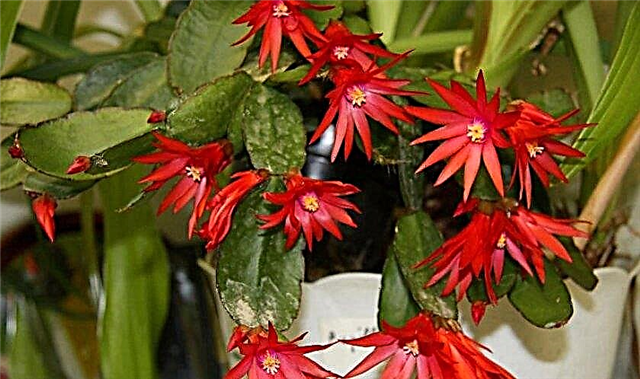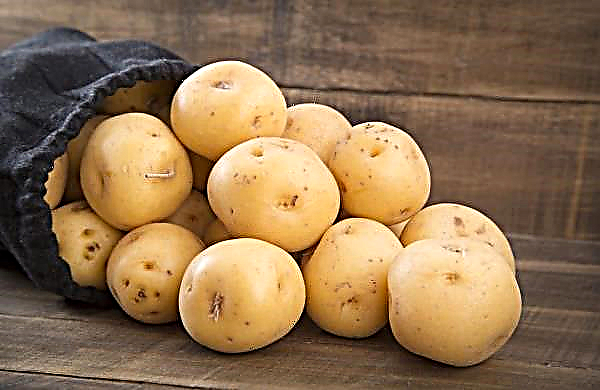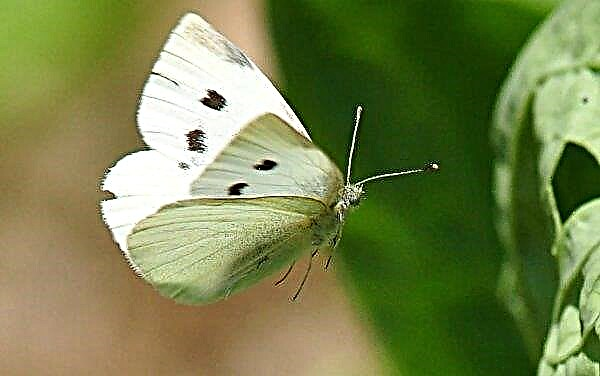Schlumbergera, zygocactus, epiphyllum are the scientific names of the plant, which is popularly called the Decembrist, Decembrine and Christmas tree. Florists love it for winter flowering, the peak of which falls on New Year's holidays. The article will focus on the features of this flower and proper care for it.
Description and features of the Decembrist
Schlumberger was brought from Brazil at the beginning of the XIX century. and assigned her the name of the French cactus collector F. Schlumberger. From the name "zigocactus" it is clear that it belongs to the cactus family, although it does not have thorns. And it is called an epiphyllum, since it is an epiphytum and does not grow on the ground, but on other plants. He does not parasitize on trees, but simply lives on them, attaching his roots to their trunk and roots.
It receives moisture and nutrients from precipitation (rain, fog). Home Christmas is low (30-50 cm in height) and very branched. Numerous stalk branches hanging down form from segments that grow from each other. The segments are flat and fleshy, resembling ribbed leaves. The root is small and rather weak. The flowers are tubular, zygomorphic (irregular in shape).
Buds are formed at the ends of the last segments. The flower tubes are multi-tiered, from which graceful long stamens peek out. Petals of various shapes: round and pointed, smooth and terry, strongly curved back and not very. In hybrid varieties, the colors are very bright: plain, with different shades, with color bordering. During the flowering period, Decembrine looks like a frozen colorful fireworks.Distinctive features include:
- the presence of air roots, except for the main ones, which develop in conditions of high humidity;
- winter bloom, which is explained by the fact that at this time in summer native to Brazil's zigocactus;
- live long: 15–20 years.
The best varieties of Schlumberger
Of all the existing types of epiphyllum, only three bloom on the windowsills:
- Schlumbergera buckley (Schlumberger boucle, or Buckley) - the oldest "resident" of window sills, which was called "Decembrist." Ampel plant. The length of the arched hanging shoots of the flower is 40–50 cm. The segments are elongated, with roundish protrusions of bright green color. Tubes of flowers are symmetrical, multi-tiered, up to 8 cm in length. The color is bright, raspberry pink;

- Schlumbergera trunkatus (truncate schlumbergera, or truncated) is distinguished by larger flowers and branches. The height of the flower reaches 50 cm. The stems are less drooping, light green in color. The segments are large: 5–6 cm in length and 2.5–3.5 cm in width. The segments have a chopped shape and sharp protrusions at the edges. The flower tube is not symmetrical, but beveled (truncated). The petals are large, curved. The colors are very different, often with a border. Blooming buds have a bizarre shape that resembles a bird in flight;

- Schlumbergera russeliana (Schlumbergera russeliana) low, up to 30 cm. Branches are glossy, with a pronounced vein in the center of each segment. The segments are small (3.5 cm in length and 2 cm in width), do not have spines and tapering. Peduncle long and greenish. Flowers with pointed petals of different shades of pink, red and purple colors.

Based on these three types of Christmas, breeders have bred a lot of hybrid varieties that differ in shapes and colors. Scientists are not yet able to obtain a zigocactus with blue flowers.
Here are some of the popular varieties:
- Angel dance Admires the dazzling white flowers. Unlike other white Christmas people, he has snow-white not only petals, but also a long pistil. Color does not change due to temperature changes;

- Malissa has a short bush with shiny small segments. The flowers are rather large, the petals are rounded, crystal white, and the pestle hanging down is pale pink;

- Ascot blooms in bright red colors. They are large, terry, with fringed petals;

- Samba brazil - a bright flower resembling a colorful dress of a samba dancer. Petals are wide, rounded, three-colored. The white throat goes into the yellow center of the petal and ends with a cherry-red edging;

- Christmas cheer - Decembrist with delicate orange flowers. Rounded petals with pointed ends are collected in a beautiful elegant basket;

- Ara brazil - motley and smart Christmas. The petals are fiery red, brightening toward the center. The flower really looks like a red macaw parrot flying among green leaves;

- Cambridge - Decembrine with bright yellow flowers and petals curved back. Articulated stems grow vertically;

- Polka dancer resembles a burning lilac flame. The petals are round, bright fuchsian in color, have a bright band on the back, and do not bend back.

Basic rules for growing and caring for the Christmas
Schlumberger can be called an unpretentious flower. But since its homeland is the Brazilian tropics, only being in similar conditions, the plant will bloom profusely every winter.
Important! The multi-colored "fireworks" looks very impressive. Such a result can be obtained if several zigocactus of different colors are planted in one pot.
Lighting and seat selection. Under natural conditions, the epiphyllum grows in the shade of huge tropical trees, so in the apartment he also prefers bright places, but away from the bright sun. Otherwise, its shoots turn yellow, and the extreme jointed leaves die off and fall off. Because of this, the flowering will be late or not at all. It does not need artificial lighting in winter. Given this, the flower can be placed on any windowsill, except the south. But if in the apartment all the windows are facing south, then in summer it should be shaded or removed away from the window (on a cupboard or bookcase). In winter, on the contrary, it would be good to put the plant on a bright southern window sill. From time to time it needs to be rotated so that the bush is formed evenly. In the summer, it is advised to take the pot out onto the street or balcony to meet the need for fresh air.
Given this, the flower can be placed on any windowsill, except the south. But if in the apartment all the windows are facing south, then in summer it should be shaded or removed away from the window (on a cupboard or bookcase). In winter, on the contrary, it would be good to put the plant on a bright southern window sill. From time to time it needs to be rotated so that the bush is formed evenly. In the summer, it is advised to take the pot out onto the street or balcony to meet the need for fresh air.
Important! In no case can you rotate or rearrange the flowering decabrine to another place. She will respond to stress by dropping buds.
Temperature. Zygocactus calmly withstands extremely low (plus) and extremely high temperatures. But comfortable are + 20 ... + 24 ° C in the summer and + 14 ... + 16 ° C in the winter. During the heating season, the pot should be kept in a cool place, away from batteries.
Air humidity should be high enough, because in nature, Schlumbergera grows in tropical rainforests. Dry air can cause buds to fall. Spraying is a necessary measure, especially in summer. The flower is moistened often, several times a week. In winter, it also needs to be sprayed if the temperature in the room is not lower than + 16 ° C. Water for spraying should be soft and warm, suitable standing, room temperature. A warm shower can replace spraying from time to time. Liquid should not get on buds. Some gardeners humidify the air by placing the pot in a pan with wet peat, sphagnum or drainage.
Water for spraying should be soft and warm, suitable standing, room temperature. A warm shower can replace spraying from time to time. Liquid should not get on buds. Some gardeners humidify the air by placing the pot in a pan with wet peat, sphagnum or drainage.
Watering should be moderate. Christmas does not like drought, but an excess of water in the pot is even worse, because it can lead to rotting of the roots and diseases. Watering is necessary as the topsoil dries, which should remain slightly moist. This regime should be adhered to all the time, except in autumn, when the plant is resting before flowering. During dormancy, watering, like spraying, should be rare, after about 7 days. For irrigation only settled water of room temperature is used.
The soil for zigocactus should be very loose, light and airy. This is due to the fact that as an epiphytic plant in nature grows without any soil at all. The substrate can be prepared according to the following recipes:
The substrate can be prepared according to the following recipes:
- peat or sod land mixed with vermiculite or coarse sand (1: 1);
- peat, sand, turf and leafy soil are mixed in a ratio of 2: 1: 1: 1.
Charcoal can be added to the prepared soil.
Pot you need to choose a wide, but low (1/3 of the height of the plant). A tall pot is not suitable for small roots. Excess space in the tank can cause the development of diseases. A prerequisite for the pot is the presence of drainage holes. The bottom should be covered with a thick layer of expanded clay or other drainage substance.
Top dressing simply necessary for the normal growth and flowering of Schlumbergera. Any complex fertilizer for cacti is suitable, only with a lower dosage. It is necessary to feed in the following mode:
It is necessary to feed in the following mode:
- during the growth period (spring – summer) - 2 times a month with nitrogen-containing fertilizer;
- during sleep (autumn) - feeding stops;
- during the setting of buds and flowering (winter) - feed phosphorus and potassium once a month.
Important! The joints cannot be cut with a knife. They need to be carefully broken off, and even better “unscrewed” by rotational movements.
It is a useful procedure that achieves the following goals:
- neat crown is formed by shortening long shoots;
- more abundant flowering is stimulated;
- the bush is gaining strength and increases the age of flowering to 20 years.
Video: Christmas Trimming
Transfer performed annually for young plants, every 2-3 years - for adults, after 5 years - for large bushes.
It is needed to:
- change the pot to a larger container;
- change the soil to a new, more loose;
- clean the root system from dry, rotten and damaged roots.
Plant diseases and pests
Epiphyllum can suffer from fungal and bacterial diseases. It is also susceptible to pest attacks. To save the flower, urgent measures are needed.
Of the fungal diseases, the most common are:
- fusarium - it affects the ground part of the bush, occurs due to mechanical damage to the stems, the method of control is fungicides;
- late blight, fitium - they affect the root neck, the cause is contaminated soil, the signs are wilting and subsidence of joints, the methods of control are Topaz, Maxim, Skor and Vitaroz preparations.
 Erwinia bacteria are identified by slippery, growing spots on the stems. The method of struggle is to remove the diseased part of the plant or destroy the entire bush.
Erwinia bacteria are identified by slippery, growing spots on the stems. The method of struggle is to remove the diseased part of the plant or destroy the entire bush.Pests:
- spider mite - a small insect, similar to red-brown specks, is characterized by the appearance of a rusty coating. Methods of struggle - means against ticks (“Fitoverm”);
- mealybug - small white lumps on the leaves. Methods of control - any insecticides ("Aktara");
- scale shield - sticky brown spots on the leaves. Methods of control - spraying with soapy water and insecticides.























